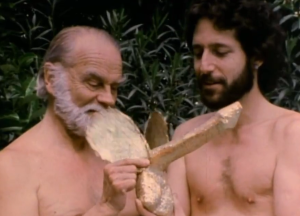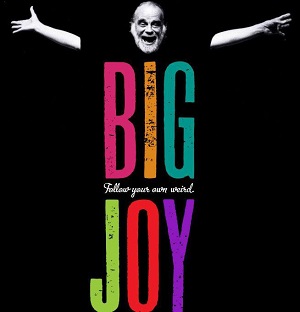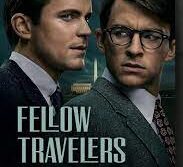 Big Joy
Big Joy
The Adventures of James Broughton
Directed by Stephen Silha and Eric Slade
Frisky Divinity Productions
JUST AS Deep Throat made hard-core pornography more acceptable for the masses in the 1970s, it was The Bed, a much lesser known art film shot in California in1968, that would usher in the era of full-frontal nudity in mainstream films. The director, James Broughton, was a pansexual, avant-garde poet and filmmaker whose whimsical poetry and surreal films first put him on the map in the 1940s. A founding member of the San Francisco Renaissance—along with Lawrence Ferlinghetti, Jack Spicer, Robert Duncan, and the rest—and one of the originators of West Coast experimental filmmaking, his pioneer work from that time is remarkable for its sex-positive sensibility and hints at the much more explicit work he would make in the 1960s, ’70s, and ’80s. Big Joy, a documentary about Brougton’s life, is a fascinating and entertaining examination of the most famous and interesting poet you’ve never heard of.
Although he never achieved the name recognition of similar artists from his time, such as Allen Ginsberg or Kenneth Anger, Broughton’s work was a seminal influence on both the beat and hippie generations. This connection is apparent in clips from Broughton’s films and in poetry readings that appear in the documentary. Many of the talking heads interviewed in the film—including Armistead Maupin, George Kuchar, and Lawrence Ferlinghetti—describe his style as “whimsical,” “childlike,” and “ecstatic.” All true. Despite the nudity and sexual themes, it would be an understatement to say he was a Peter Pan. He had a wonderfully childlike exuberance and bohemian approach to life that makes it easy to understand why the beats and hippies loved him so much. But it also explains why many will perhaps find him cloying, like a twelve-year-old Dr. Seuss, albeit with the face and body of Walt Whitman. From his “Hymn to Big Joy”:
He He Oh He
He is the completest zany of a He
He is the immaculated jeu d’esprit
He is the aorta’s jigamaree
He Oh He He
His is the reekingest smell of free
His is the deafening fart of glee
His is the jocosity’s apogee
Oh He He He
laughiest daffiest verity
This childlike approach to life and art was accentuated by Broughton’s androgynous voice and mannerisms— think Carl Sandburg crossed with Truman Capote—which makes you wonder how things might have turned out for him had he been born with a voice with more gravitas, like Allen Ginsberg.

But as the film explains through interviews and archival footage, Broughton’s fey mannerisms and androgynous persona are the key to understanding his life and art. Like many gay artists, he had a tortured relationship with his mother, who despised him for being effeminate. In one revealing segment, we learn from Broughton’s childhood diary that, in an effort to “cure” himself of his effeminacy, he asked his mother to subtract a quarter from his allowance every time he acted girly. This struggle with traditional gender norms would persist for most of his life, and it partly explains why he spent years in Jungian analysis and had affairs with both men and women, including film critic Pauline Kael, who helped him make his second film, Mother’s Day (1948), a surrealist black-and-white celluloid poem in which childlike adults play hopscotch, twirl hula hoops, swing on swing sets, and so on. After having had such a joyless childhood, it’s no wonder Broughton’s first serious attempt at filmmaking would be about the importance of play, even for adults. It was his signature theme, one he would explore for the rest of his life.
Although they never married, Kael and Broughton had a daughter together, and Kael introduced him to his first long-term male lover, Kermit Sheets. Sheets was an actor, director, playwright, and founder of Centaur Press, perhaps best known for publishing Anaïs Nin’s first work of fiction, House of Incest (1936). Sheets collaborated with Broughton on several films, including The Pleasure Garden (1953), which was given a special jury award at Cannes by Jean Cocteau for Best Fantastic-Poetic Film, which resulted in Broughton being offered a job directing a commercial film. When he declined the offer because he was more interested in writing poetry at the time, Pauline Kael told him it was the biggest mistake of his life.
Always one to follow his own drummer, Broughton focused on writing poetry for over a decade and didn’t make another film until 1968, when he made The Bed, his first color film. A 22-minute pæan to hippiedom, the film has no plot, just beautiful, mostly naked bodies—male, female, gay, straight, black, white, young, old, lizard, snake—playfully cavorting on a big brass bed that has somehow found its way into a meadow. Besides being so incredibly relaxed about nudity for its time, the film is also casual regarding drug use, as in one scene where a couple smokes a joint in bed. In another scene, a priest played by Alan Watts gives a dying man (Kermit Sheets) last rites before he dies in bed. Broughton himself stars in the film, as a grizzled Pan-like figure who plays saxophone in the nude while sitting on the bed’s brass headboard. This film has such an iconic feel to it—could it be the most quintessentially hippie film ever made?—one wonders why it’s not better known, at least among art film aficionados outside of San Francisco.
After The Bed, Broughton continued writing poetry and making playfully erotic art films with a distinctly West Coast vibe, films full of dance and joy, magic and myth. He died in 1999, at the age of 85. The makers of Big Joy were able to use unlimited footage from his films, having secured permission from Joel Singer, his last lover and the executor of his estate. The clips are beautifully photographed and often very sexy, although the eroticism is tempered by Broughton’s whimsical sense of humor, at least in the clips shown in the documentary.
In addition to being a great introduction to Broughton’s work, the film’s exploration of his complicated sexuality serves as a fascinating case study of how homophobia is bad for both gay and straight people. Although he had relationships with both men and women, and even got married in 1962—on the advice of his Jungian therapist and fellow experimental filmmaker Stan Brakhage, who both thought it would “straighten him out”—Broughton began to identify more as a gay man in the ’70s. Indeed, while teaching film at San Francisco Art Institute, he fell in love with the aforementioned Joel Singer, a student, and left his wife and children to be with him.
Broughton and Singer would stay together and collaborate on films until Broughton died almost 25 years later. In interviews with his ex-wife and adult son—his two daughters declined to be interviewed for the film—it’s obvious that Broughton’s coming out was extremely traumatic for his family. But considering his history and the nature of his work, it’s hard to believe his wife could have been caught unawares. It’s unclear whether the acrimonious breakup was a classic case of a narcissistic artist who callously followed his muse and his groin or a bitter wife who wanted nothing more to do with her newly gay husband. In any event, the viewer is left with more questions than answers on this issue.
Jim Farley is an associate editor of this magazine.






